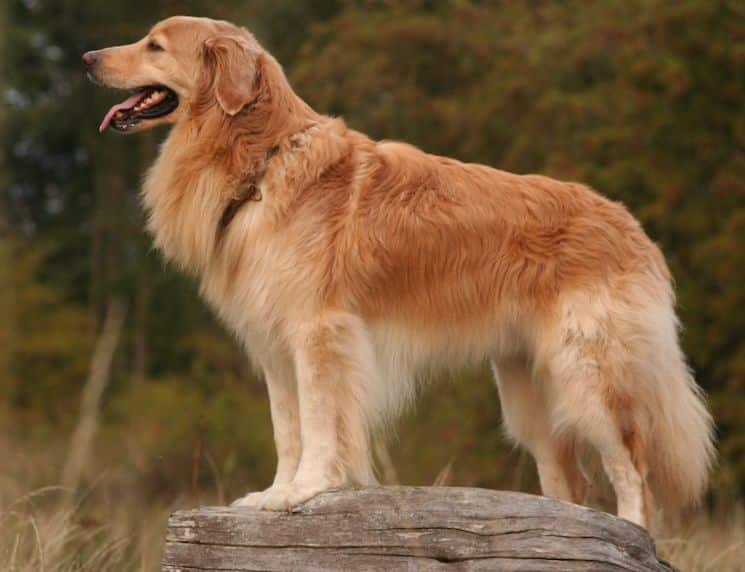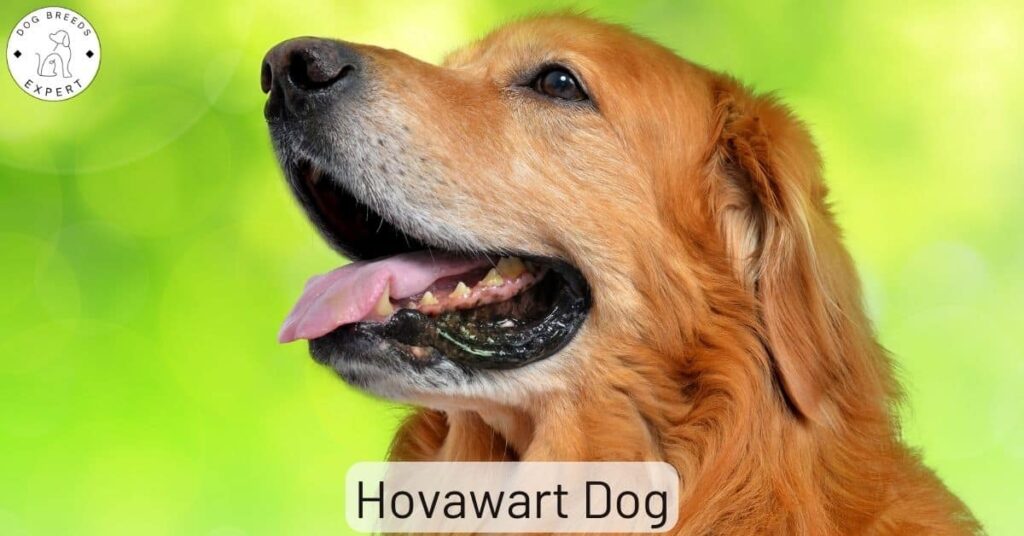A large, intelligent livestock guardian breed.
The Hovawart dog breed has its roots in Germany, where it’s name is derived from the German for “farm” (Hof) and “guard” (Wächter). The modern-day Hovawart is actually a relatively recent reconstruction of the old farm and guard dogs, created by breeding the German Shepherd with Newfoundlands and Leonbergers in the early 1900s. The breed was officially recognized by the FCI in 1937.
The Hovawart dog breed comes in 3 colors – a fawn or golden color, a black-and-gold color, and a pure black color. The fawn colored dog is sometimes mistaken for a Golden Retriever, but the Hovawart is bigger and heavier.

Hovawart Dog – Temperament
Like most breeds originating as Livestock Guardian Dogs, the Hovawart is initially suspicious of strangers, and will usually not approach someone it doesn’t know. But these dogs make excellent family pets, as they love being part of a family and bond very strongly to their home group. They are protective of their owners, and will bark loudly to alert them of anything amiss; however they are not aggressive.
Bear in mind that this is a working dog breed, and is happiest when it has a job to do or something to occupy its mind. They are intelligent, and may not be the easiest breed to train, as they need careful and consistent handing. Probably NOT a breed for first-time dog owners, unless you have a good professional trainer nearby.
A Hovawart needs room to move, preferably a large well-fenced yard. They need a good hour of activity every day, plus a few shorter walks morning and evening. They are not really suited to apartment living, unless you have a big apartment and a convenient area nearby to exercise the dog.

Hovawart Dog – Breed History
The first references to a dog identifiable as a Hovawart were in the 15th century in Germany. They were used for guarding farmsteads, livestock, and in tracking.
In the years leading up to the 20th century their popularity slowly declined, as other breeds such as the German Shepherd were developed. By the beginning of the 1900’s, there were very few Hovawart-type dogs left, and a small group of enthusiasts decided to try to save the breed from total extinction.
This group started by acquiring the remaining Hovawart-type farm dogs throughout Southern Germany, to establish a basic stock. These dogs were then bred with a number of other breeds to bring the Hovawart back to the size, shape, appearance and temperament of the descriptions of the early farm dogs. It is believed that German Shepherds, Leonbergers, Newfoundlands and Kuvascz breeds were involved.
The German Breed Register first accepted a litter of Hovawart puppies in 1922, and then in 1937 the breed was recognized by the FCI. It seemed the Hovawart dog breed had been re-invented and saved. But then World War 2 came along, and very few people had the time, money nor opportunity to continue with breeding.
As well as a lack of breeding during the War years, many Hovawarts were used in military service, and were killed in action. After the war, in 1947, another group of breed enthusiasts established a breed club in the city of Coberg. Gradually, the breed was re-established, and slowly gained in popularity, until recognition was awarded by the German Kennel Club in 1964.

Vital Statistics;
Height; 25 to 29 inches (male), and 23 to 26 inches (female)
Weight; 65lbs to 110lbs
Life Span; 10 to 14 years
Colors; Gold or Fawn, Black and Gold, or Pure Black.

Ease of Training
This is an intelligent breed, which means they can pick up instructions pretty quickly if they want to. The trick lies in working with the way these dogs think! As livestock and guardian dogs, they had to think and act independently from their owner at times. This gives them a mind of their own.
However, with careful and early socialization, they become accepting of strangers and new situations. Early training should be kept to short sessions of 5 to 10 minutes, repeated 2 or 3 times a day, to avoid boredom setting in. A consistent approach to commands, with lots of praise and treats for correct behavior will teach the young Hovawart how to learn. This makes subsequent training when they are older much less of a chore.
This is a breed that will readily work with you, but not necessarily work for you, unless well motivated. You need to keep up consistency and rewards during training for the entire life of the dog.
The Hovawart has a good sense of smell, and they generally do well in Search and Rescue roles, whether working with the authorities or else in Search and Rescue trials and competitions.

Protection
The Hovawart dog breed is an excellent watchdog. With Livestock and Farm guarding in it’s genes, it will always retain an element of reservation with strangers, and not trust them to enter it’s territory without raising the alarm.
This is a big dog, potentially weighing up to 110lbs (50kg), and they have a deep and intimidating bark. This will be enough to deter most unwanted guests. On top of that, their sheer physical size (especially the males) can be imposing.
When it comes to taking action, they are not aggressive by nature, and are more likely to simply stand their ground barking than actually attack.

Grooming
Because the Hovawart does not have a thick undercoat, it does not shed much short, fine hair at all. The longer top coat needs to be brushed through once a week at least, and this coat will shed seasonally, once a year.
An occasional bath will be needed if the long coat gets dirty or muddy, or the dog starts to develop that ‘doggy’ smell.
FURminator deShedding Tool
We have found that the absolute best way of grooming any long haired dog breed is to use the FURminator grooming tool! We highly recommend this unique brush from Amazon to keep your dog in tip top shape. Click on the image below to find out more…

Health Considerations
The Hovawart dog is exceptionally healthy, as a result of the rigorous breeding standards laid down in Germany. They have the longest life span of any breed this size, and there are no breed-specific issues. The AKC website states that hip dysplasia rates are below 5%, which is exceptional for a dog of this size and weight.
Famous Hovawart Dogs
I could not find any famous Hovawart dogs – if you are aware of one, please let me know using the Contact Me link. Thank you!



